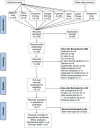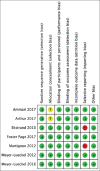Efficacy of Resin Infiltrate in Noncavitated Proximal Carious Lesions: A Systematic Review and Meta-Analysis
- PMID: 31198691
- PMCID: PMC6559044
- DOI: 10.4103/jispcd.JISPCD_26_19
Efficacy of Resin Infiltrate in Noncavitated Proximal Carious Lesions: A Systematic Review and Meta-Analysis
Abstract
Objectives: Resin infiltration is a minimally invasive technique for treating noncavitated proximal caries. It slows/stops the carious lesion progression rate by creating a diffusion barrier inside the porous enamel lesion body. The aim was to evaluate the efficacy of resin infiltration on noncavitated proximal carious lesions in primary and permanent teeth.
Materials and methods: The records were obtained using electronic and other sources. The Preferred Reporting Items for Systematic Reviews and Meta-Analyses guidelines were followed to ensure transparent reporting. Eligible studies were randomized controlled trials evaluating the efficacy of resin infiltration for noncavitated proximal carious lesions by comparing it with control/placebo. Each included study was assessed concerning the "risk of bias" using the Cochrane Collaboration's "risk-of-bias" assessment tool. High risk-of-bias studies were excluded from the meta-analyses due to selective reporting matters. The statistics were performed by RevMan software (The Cochrane Collaboration, The Nordic Cochrane Centre, Copenhagen, Denmark) utilizing the random effect model. The GRADE approach was implemented for assessing the quality of evidence.
Results: From 106 studies identified, 17 were assessed for eligibility. After "risk-of-bias" assessment, two meta-analyses were conducted to eliminate the limitation of the significant heterogeneity between trials inspecting primary teeth (n = 2) and permanent teeth (n = 3). I 2 = 0% indicates the absence of statistical heterogeneity. The risk of carious lesions' progression with resin infiltration was significantly lower in primary (risk ratio [RR]; 95% confidence interval [CI]: 0.48; 0.30-0.75, P = 0.001) and in permanent teeth (RR; 95% CI: 0.19; 0.11-0.33, P < 0.00001) compared to that of control/placebo. The GRADE approach revealed high quality of evidence.
Conclusion: The available evidence conveys high confidence that proximal resin infiltration has superior efficacy in slowing/arresting the carious lesions' progression rate in comparison to conventional management modalities.
Keywords: Efficacy; permanent teeth; primary teeth; proximal carious lesions; resin infiltration.
Conflict of interest statement
There are no conflicts of interest.
Figures




References
-
- Mejàre I, Stenlund H, Zelezny-Holmlund C. Caries incidence and lesion progression from adolescence to young adulthood: A prospective 15-year cohort study in Sweden. Caries Res. 2004;38:130–41. - PubMed
-
- Altarabulsi MB, Alkilzy M, Splieth CH. Clinical applicability of resin infiltration for proximal caries. Quintessence Int. 2013;44:97–104. - PubMed
Publication types
LinkOut - more resources
Full Text Sources

